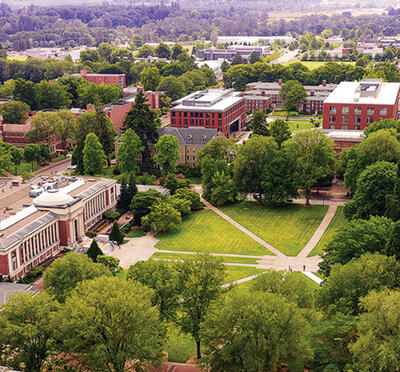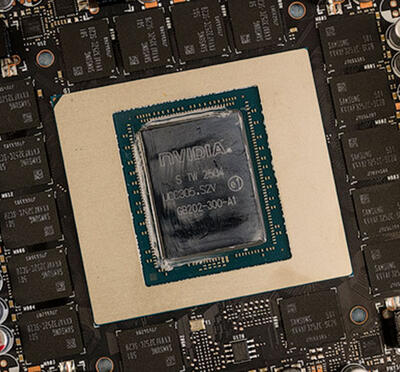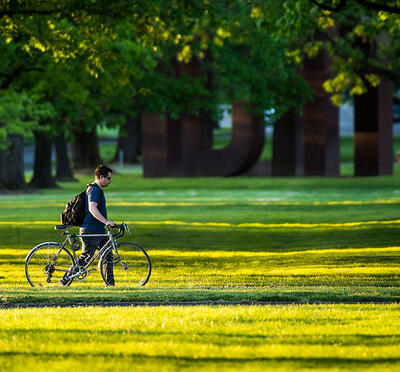If John Lienhard could eradicate one word from the English language, it would be “innovation.”
“It’s a waffle word. How about that?” he said, offering a more temperate formulation in place of one deemed too salty for print.
Lienhard prefers “invention,” a word that industry leaders conspicuously avoid, he says, because of its world-changing implications.
“People are afraid of invention; they’re afraid of creativity,” he said. “Industry seizes on that toned-down word, innovation. What does it mean? It means tinkering a little bit, taking something that already exists and making it new. It’s a word that avoids the hard fact that invention is dangerous.”
Lienhard, B.S. mechanical engineering ’51, has a keen interest in how inventive minds work. Since 1980, when he joined the faculty at the University of Houston, he has held positions that included an element of the history of technology. Today, at 92, he holds the title of M.D. Anderson Professor of Technology and Culture, emeritus. Long retired, he still shows up to work on the radio program he launched more than three decades ago.
Born in 1930 in St. Paul, Minnesota, Lienhard came to Oregon in his teens when his family moved to Roseburg. He struggled in school, having never heard the word “dyslexia.” (“The official diagnosis back then was ‘lazy and stupid,’” he says.) In lieu of any support for students with such difficulties, he invented his own “workarounds,” and he persevered.

“I found ways of seeing things spatially that others were seeing symbolically, or algebraically,” Lienhard said. “I had very high space-recognition ability. It wound up equipping me to succeed in engineering in a way that other people couldn’t succeed.”
After chewing his way through two years of pre-engineering at Multnomah Community College, Lienhard arrived at Oregon State College in 1949. The campus was inundated with World War II veterans, holding Uncle Sam to his promise made in the GI Bill. They were crammed into squalid, barracks-like housing, hastily erected upon muddy flats on the western edge of campus and at Camp Adair, north of town.
Class sizes were huge by today’s standards, with recent graduates pressed into service to teach introductory courses. Professors sought to winnow the horde by subjecting students to punishing workloads.
“It was a purely Darwinian process,” Lienhard recalled.
Less seasoned and a full decade younger than his war-tested classmates, Lienhard would have to fight to keep his seat. He credits one fluid dynamics instructor — who bluntly counseled him over coffee to give up hope of ever becoming an engineer — with providing him the animus to succeed.
“It was a very important moment,” Lienhard said. “I had to decide that he was wrong, and I had to figure out how to make the fact of his wrongness come true.”
After graduating in 1951, Lienhard went first to Seattle, where he worked for Boeing and earned his master’s degree at the University of Washington, before being drafted into the Army in 1953. He moved to the University of California, Berkeley, in 1956 to serve as an engineering instructor and earned his doctorate there in 1961. His academic career then took him from Washington State University (1961-1967), to the University of Kentucky (1967-1980), and, finally, to the University of Houston.
Lienhard’s engineering research focused on heat transfer and thermodynamics. His work garnered awards and honors, including induction into the Oregon State Engineering Hall of Fame in 2000 and election to the National Academy of Engineering in 2003. But perhaps his greatest pride is the heat transfer textbook he first published in 1981, and which is still used in engineering programs around the world. The current, fifth edition, issued in 2020 in collaboration with his son John Lienhard V, is available for download as a free e-book from MIT.
For all his accomplishments as a professor of engineering, Lienhard is more widely known as a preeminent historian of technology, through the radio program he started in 1988.
“Engines of Our Ingenuity,” a four-minute broadcast about “the machines that make our civilization run, and the people whose ingenuity created them,” airs on public radio stations around the country five days a week. Produced by Houston Public Media, the program reaches a much larger audience these days through its podcast.
Each episode — the archive has more than 3,000 — consists of a short essay, read by Lienhard or another contributing writer, that tells the story of “how our culture is formed by human creativity.” Many of these focus on inventors from long ago, whose inventions we might take for granted today. Just consider, for instance, where we would be as a species without the wheel and crank (episode No. 24) or even the humble paper bag (No. 2,171). Other episodes take a wider view of the creative process and that “dangerous” practice of invention.
Invention is dangerous, Lienhard says, because it disrupts the existing order and challenges old ways of doing things. Progress depends on such disruption, so Lienhard believes engineers need to face the danger head on. Still, he acknowledges that changing the world brings with it the responsibility to be mindful of consequences, both intentional and otherwise.
“There’s no new technology that enters our lives that does not have revenge effects,” Lienhard said. “The automobile, penicillin, the internet — just go down the line. And yet, we human beings are bound to invent, because we cannot live without the fruit of invention. We are the only species that is bound to our technologies. It’s a very, very strange and complex relationship.



